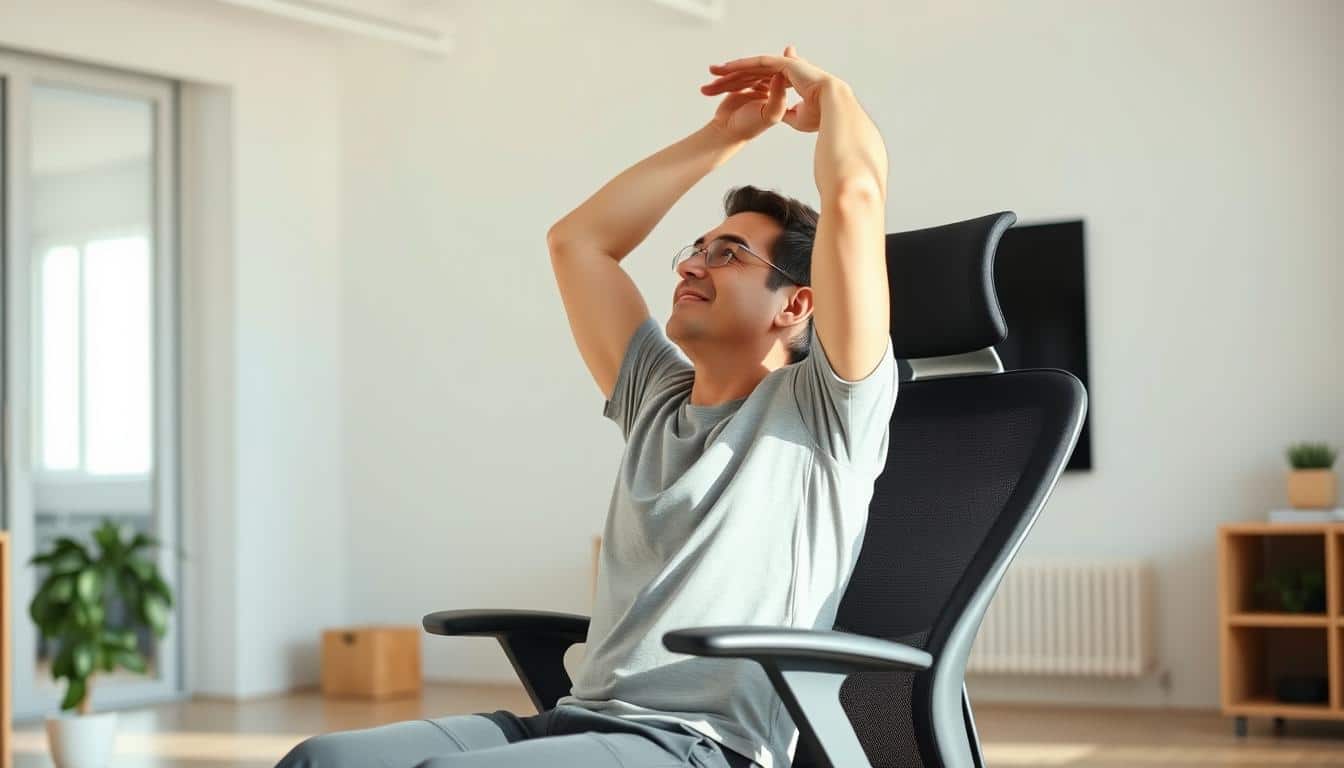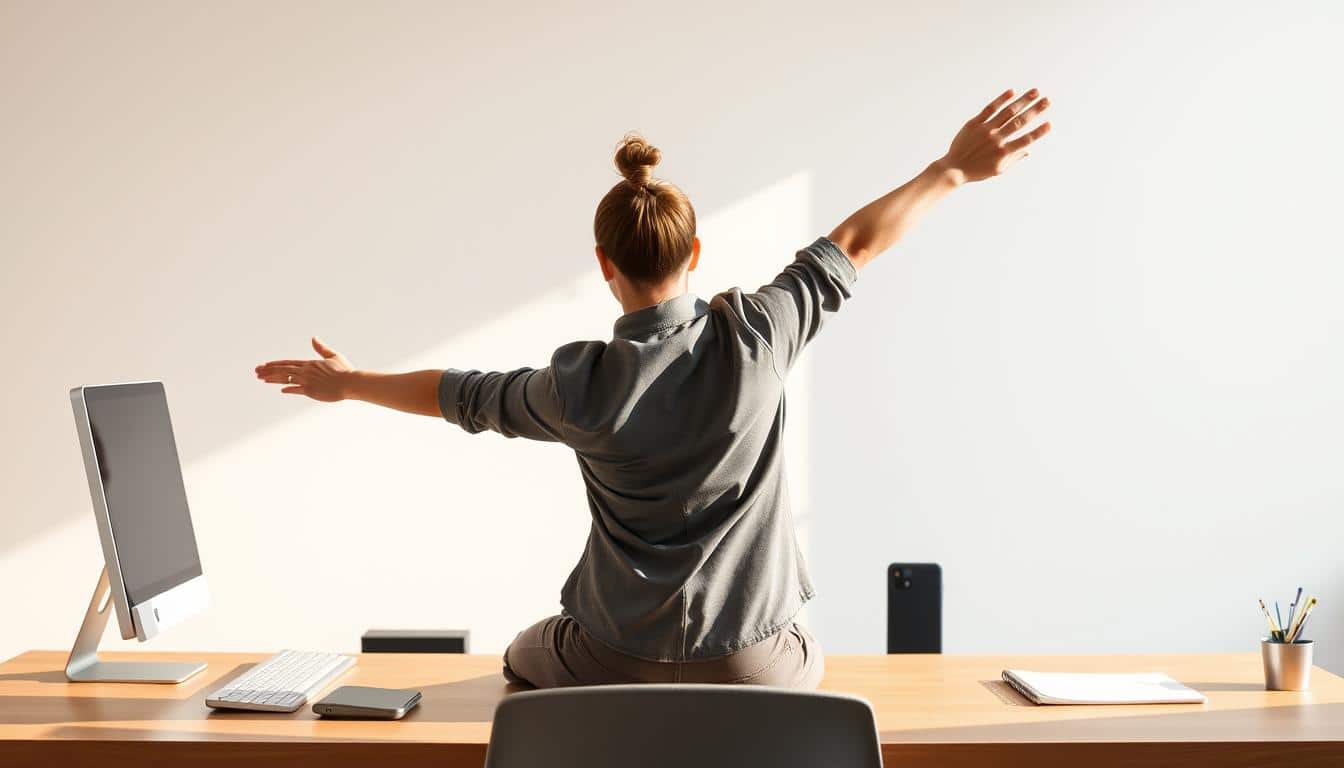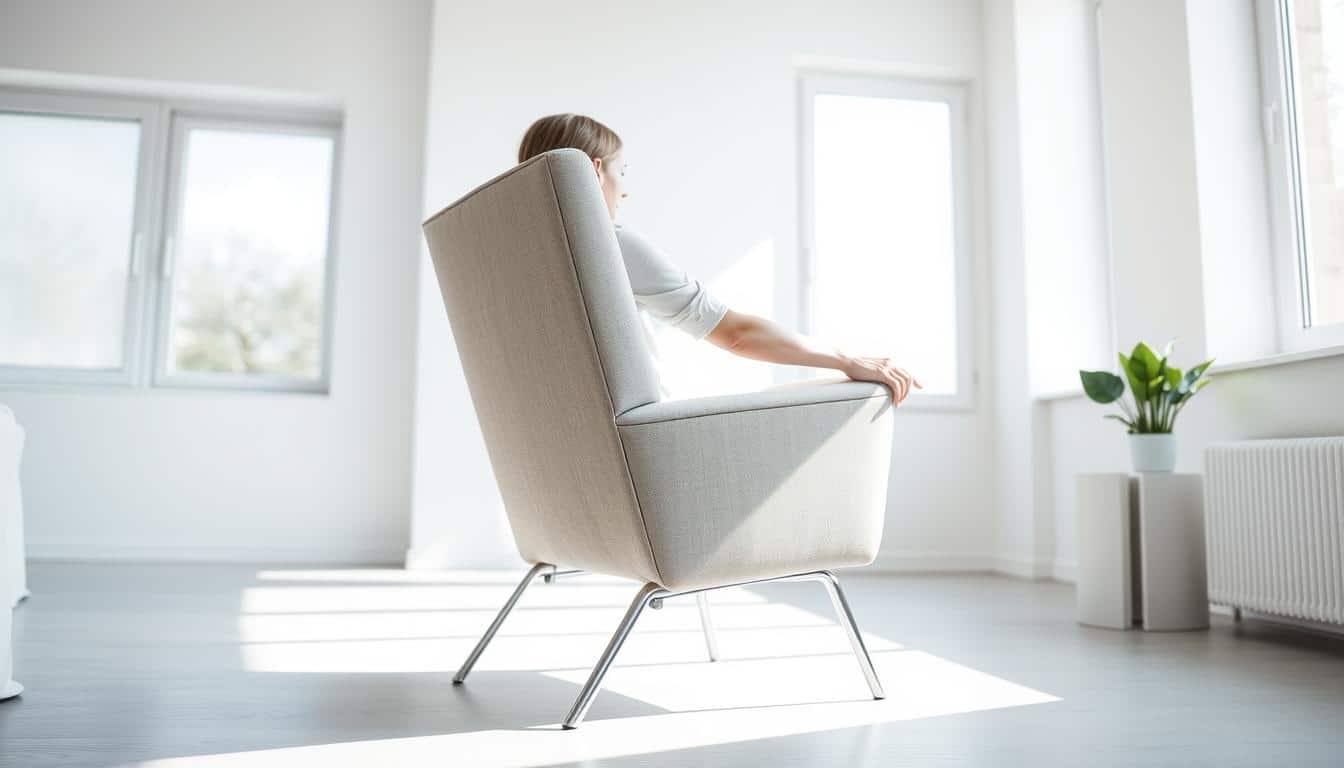In our busy work life, it’s super important to stretch while in the office. About 80% of workers in the USA sit all day, raising the risk of sore muscles. Doing easy stretches at your desk can lessen discomfort, make you more flexible, and boost your work output. Regular stretching can cut down pain by 72%, showing it’s key for staying healthy at work.
The folks at Harvard School of Public Health tell us that moving a little can make us happier. This leads to a better vibe at work. Try doing arm, overhead, and hip stretches to feel better and break up the day. Adding some sneaky stretches to your day can help keep your body and mind sharp.
Anúncios
The Importance of Movement at Your Desk
Moving during the workday is crucial for your body and mind. Sitting too long can lead to back pain, weight gain, and heart problems. Moving around improves blood flow and relaxes your muscles, making you more focused and healthy. Stretching regularly is important too, as it helps offset the downsides of sitting too much.
Most Americans, about 80%, don’t get enough exercise. This shows we need new ways to keep fit at work. Simple steps like using the stairs, parking further away, and walking during breaks can help a lot. Drinking more water also makes you move more, as you’ll need to refill your bottle.
It’s good to stretch or do mini workouts hourly. You can try things like spinning in your chair, doing push-ups against your desk, or squatting with your chair. These small exercises keep you from getting stiff. They also increase your energy and blood flow. Stretching often can reduce back and neck pain, improving your overall health.
Understanding the Risks of Sedentary Work
Sitting too much at work is a big problem with serious consequences. Most adults in the U.S. sit for about eight hours each day, often without taking a break. This habit can lead to health issues like chronic pain in the neck, shoulders, and lower back. Over time, sitting too long every day can cause severe health problems.
Jobs that involve sitting for more than 30 minutes at a time are especially risky. They can lead to health problems such as:
- Cancer, notably breast, colon, endometrial, and ovarian
- Cardiovascular disease and hypertension
- Chronic musculoskeletal issues, like persistent knee pain
- Obesity and associated weight gain
- Poor bone health, including osteoporosis
- Type 2 diabetes and other metabolic disorders
- Mental health concerns, encompassing stress, anxiety, and depression
Even active people can be at risk if they sit a lot at work. The negative impact of sitting too much adds up. It leads to health issues that cost about $225.8 billion every year due to lost productivity.
To fight these risks, try to move more during your workday. Take short breaks every hour, use a standing desk, or do some stretches right at your desk. Activities like walking on your break, using the stairs, or taking public transport can help you move more. Workplaces can help by promoting wellness programs. These efforts can help reduce sitting time and improve employees’ health.
Office Stealth Stretching: Simple Moves to Try
Adding stretches to your daily office life can really boost your comfort and productivity. Small moves can ease tension and fight off stiffness. Here are some great office stretches to keep you flexible at your desk.
Stretching your arms and shoulders
Doing arm and shoulder stretches during the day can ease discomfort. Try lifting your arms while seated to gain strength. Also, for more relief, stretch your chest by putting your hands together behind your back and pulling gently. Don’t forget to stretch your neck to release tension. Keep each stretch for 10-30 seconds to make it work.
Torso twists for back relief
Torso twists can make your spine more flexible. Sit with your feet flat and turn your upper body towards one arm on the chair. This can loosen up your back. Hold this twist for 10-30 seconds before you come back to the start. Adding this stretch to your day helps against the problems of sitting too much.
Leg and knee stretches
While you’re seated, you can still stretch your legs. Bring your knees up to your chest to stretch your lower back nicely. To increase flexibility, straighten each leg out one at a time for a hamstring stretch. Try lifting your legs while sitting to strengthen your thigh muscles. Doing these leg and knee stretches often can help your circulation and reduce sitting discomfort.
Effective Desk Exercises You Can Do
Adding quick desk exercises to your day boosts your health at work. Doing simple actions helps break long hours of sitting. They improve blood flow and lessen discomfort. Make these exercises part of your daily habit.
Neck rotations
To relieve neck tension, start with gentle neck rotations. Lower your chin to your chest, then slowly turn your neck to one side and then back. Do this by moving your head side to side. Neck rotations are great for refreshing your mind during a busy day.
Back twists
Back twists can make your spine more flexible. Sit up straight and gently turn your upper body to one side, holding briefly. Then switch to the other side. This movement stretches your back, easing stiffness from sitting too long.
Gluteal squeezes
Gluteal squeezes strengthen your core muscles quietly. Tighten your glutes, hold for 30 seconds, and release. This helps build endurance in your muscles. Doing these at work also helps improve your sitting posture.
Inconspicuous Ways to Stay Active
Staying active at work doesn’t need a lot of time or effort. You can easily add simple office exercises into your day. For example, doing neck turns and leg stretches keeps muscles flexible without anyone noticing.
Walking for short times or taking the stairs can boost your energy. Standing or moving around during phone calls increases blood flow and makes conversations more lively. You can also do muscle tightening exercises, like squats or thigh squeezes, right at your desk.
Using items like a stability ball can make your core strong and fix your sitting posture secretly. You might also keep a yoga mat or small hand weights nearby for quick workouts. Putting reminders to move around or using a stand-up desk can also help keep you active.
Even tiny movements count towards being healthier. Doing things like lifting your calves or trying chair yoga improves your movement and blood flow. Over time, these small exercises create a healthier work environment and help meet exercise goals.
Creating a Stretching Routine at Work
Starting a daily stretching routine at work boosts your well-being. It’s key to move during office breaks to fight off sitting too long. Taking breaks often reminds us to stand up, stretch, and do small exercises. This makes for a healthier, more efficient work environment.
Setting timers for breaks
Using timers helps manage break times well during work. Try these tips:
- Set an hourly reminder to stand up and stretch.
- Incorporate simple moves like calf raises, or seated cat-cow stretches every hour.
- Engage in glute squeezes while sitting for 30 seconds, followed by briefly standing for leg extensions.
Incorporating movement into meetings
Making meetings active boosts attention and health. Here are some ideas:
- Transition to standing meetings whenever feasible.
- Allow time for arm stretches, chair core twists, or ankle rotations during discussions.
- Utilize opportunities for walking in place or performing wrist stretches while brainstorming ideas.
The Benefits of Office Stealth Stretching
Adding stretching to your work routine brings lots of benefits. It helps not only with your body but also makes you feel better at work. Doing stretches often makes you healthier and your work life better.
Improving posture and range of motion
Stretching makes your posture better and makes you more flexible. The Chin Retraction stretch makes your neck stronger and helps with headaches. It also eases shoulder and wrist pain. The Chest Opener stretch loosens tight chest muscles, helping with pain in the neck, shoulders, and lower back.
Doing these stretches during the day keeps you comfy and pain-free. Plus, using stuff like adjustable chairs and standing desks makes stretching even better. They help you keep a good posture while you stretch.
Reducing stress and enhancing focus
Stealth stretching at your desk can help you feel less stressed and more focused. Moves like spinal twists and desk push-ups get your blood flowing. They also help clear your mind. Studies show that moving around at work improves your mood and lowers stress. This means you can focus better after taking a break.
Stretches like the Seated Hamstring Stretch and Seated Piriformis Stretch tackle hip tightness and discomfort. When people know how to move and stretch properly, they feel less tired. They also feel more driven during their workday.
How to Integrate Fitness with Your Daily Routine
Adding physical activity to your workday is easy and beneficial. Using strategies to combine fitness with work boosts health and productivity. By using flexible standing desks and having walking meetings, you can move more while doing your job.
Using flexible standing desks
Adjustable desks let you switch between sitting and standing during your day. This change reduces the bad effects of sitting too long, helping your circulation and focus. Standing desks help you use your muscles and improve your posture. Finding the right mix of sitting and standing boosts comfort and work performance.
Taking walking meetings
Make meetings active by walking while you talk. Going outside or using a nearby walking path can make you more creative and keep you active. Walking while talking helps teamwork and makes meetings less stationary. This way, you show how to combine work and fitness smoothly.

Innovative Tools for Office Stretching
Adding new stretching tools to your office can make you more flexible and healthy. There are many options to fit everyone’s needs and tastes. This makes it easy and effective to stay active while working.
Desk equipment options to consider
For a lively workspace, think about using these desk tools:
- Half-round foam roller for calf stretching and balancing
- SoleMate for balancing and foot exercises
- Textured balls for foot rolling
- Anti-fatigue mats that enhance standing comfort
- Movemate board for encouraging play and movement
- Adjustable-height desk for dynamic movement
- Yoga props like foam wedges and sit pads for varied seating positions
- Ergonomic stool to promote good posture and core strength
- Stability cushion for maintaining proper posture
- Resistance bands for discreet strength training
- Small hand weights for improving circulation
- Yoga/exercise mat for stretching or Pilates
- Massagers to relieve muscle tension
- Under-desk bike for low-impact cardio exercises
- Mini-desk elliptical to promote activity
Apps for scheduling breaks
Break reminder apps help you move regularly. StretchClock reminds you to take breaks for stretching. Setting a timer for every 15 to 30 minutes gets you off your screen. It helps blend stretching into your day.
Personal Experiences with Office Stealth Stretching
Many workers tell stories of how stealth stretching at work has changed their lives. One person talks about sitting for 35 hours a week. They started stretching every 30 minutes. This helped them feel better despite sitting for so long.
Another worker takes 15 minutes in the mid-morning to stretch and walk. This small break lowers stress. In the afternoon, they walk their dogs and stretch at 3 p.m. These stories show that short breaks can boost happiness and well-being at work.
One popular stretch is the Office Chair Torso Twist, with six steps. It helps with posture and strengthens the core. A daily three-minute hip stretch also made someone’s hips less stiff and improved motion.
Other stretches like neck tilts, reach ups, and knee holds help after sitting a lot. Employees say stretching makes them more flexible and lowers injury risks at work. If more people start stretching at work, it could lead to a healthier work environment.
Promoting a Culture of Movement in the Workplace
Creating a workplace that values movement is key for employee health and productivity. Employers are important in making this active environment. They can start fitness challenges like step count contests or online races to get everyone moving, no matter their fitness level. These activities lift spirits and make physical activity a fun part of work.
Using adjustable desks and ergonomic chairs helps with good posture and movement. Workshops on posture can teach employees how to stay healthy. Having meetings where everyone stands can cut down on too much sitting, making people more active.
Offering rewards for being active can build a supportive culture. Things like gift cards or extra vacation days motivate employees to stretch and move around. Taking breaks for fitness during the day can also make employees more energized and focused.
Adding things like chair yoga, yoga classes, or walking meetings can make the workplace livelier. These activities boost creativity, lower stress, and encourage moving around. Companies like Schindler Elevator Corporation show that focusing on wellness can lead to fewer people missing work and more engaged employees.
Conclusion
Ending on a high note, adopting office stealth stretching is key for a healthy office vibe in our hectic work life. James Levine highlights that moving around is the answer to beat sitting too much, not just standing up. By doing easy stretches and moves every day, we can beat the soreness and problems from sitting too long.
Making your workspace comfy and ergonomic is really important. Small tweaks like adjusting your chair or organizing your desk can boost your health and work output. Adding movement, like using stairs, picking a printer that’s further away, or having meetings on the go, can make us 15% more productive. It also leads to lasting health perks.
Encouraging staying active at work helps everyone feel better and work better together. When companies care about such practices, they build a lively work setting. This makes life better and work more satisfying for everyone.
FAQ
What is Office Stealth Stretching?
How can stretching improve my productivity at work?
What are some examples of stealth stretches I can do at my desk?
How often should I take stretching breaks?
Can stretching help prevent injuries associated with sitting for long periods?
What tools can enhance my office stretching routine?
How can I create a routine for stretching at work?
What are the mental health benefits of stretching at work?
Can walking meetings be beneficial for my health?
Are there any apps that can remind me to stretch?
Content created with the help of Artificial Intelligence.



